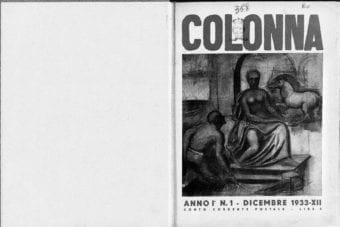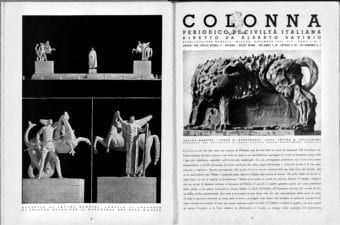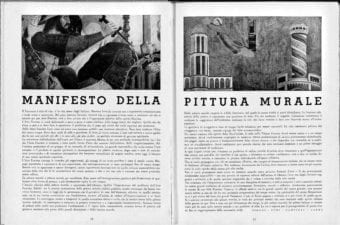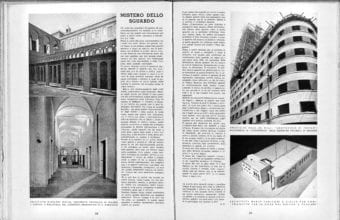Alberto Savinio and the “Years of Consent”: The Experience of “Colonna” (1933–34)
Lucilla Lijoi Lucilla Lijoi Alberto Savinio, Issue 2, July 2019https://italianmodernart-new.kudos.nyc/journal/issues/alberto-savinio/
This presentation considers the significant role Alberto Savinio played in the production and promotion of Italian culture during the early thirties, focusing specifically on Savinio’s founding and directing of the monthly review Colonna. Periodico di civiltà italiana. Although Colonna folded after only five issues, during its run the periodical served as a vehicle for Savinio to actively contribute to the revival of Italian culture as well as the movement around the “uomo nuovo italiano,” which was promoted by Fascism in the so-called “years of consent.”
Crucial to confronting the delicate relationship of Alberto Savinio to fascism in the early thirties is the consideration of his decision to establish Colonna (figure 1), a monthly journal of art and culture that was partially in line with the cultural direction being promoted by Benito Mussolini. An important date in this history is 1933, the year in which Savinio moved to Italy with his family after several years in Paris. The Italy of the early thirties was very different from the country Savinio had left in 1926. In fact, Mussolini was pursuing the total “renovation” of the Italian people in his attempt to create “the new fascist man,” a protagonist for both the Mediterranean and Europe. In so doing, he intended to bring Italy back to the splendors and glories of the Roman Empire and the Renaissance. The “new man” to be born would be at once ancient and modern, conscious of tradition but also ready to revolutionize the old liberal system and to assert himself over the ruins of a Western world both decadent and insufficient.

When Savinio returned to Italy, he entered into a climate that Renzo De Felice has deemed “the years of consent” due to the enthusiasm intellectuals showed for Mussolini’s project. Savinio interacted with the most influential cultural circles in the country, collaborating in his own right in the grandiose plan of rebirth.1 In his journalistic writings of this period, published in the most important Italian newspapers, Savinio insisted repeatedly on the superiority of the southern (Latin) man over the northern (Gothic), thus aligning himself with opinions widely shared among Italian intellectuals. Savinio had also read Oswald Spengler’s Der Untergang des Abendlandes (The decline of the west, 1918–22) and believed that the Western world was in crisis, even on the brink of death. But, differently from Spengler, he thought that Italy did not really belong to the West but rather constituted a world of its own, untouchable as “a salamander that defies the flame,”2 and that the country could, finally, take advantage of the crisis to rise again, stronger and healthier than ever.3
Savinio had great faith in Italy’s artistic and cultural traditions, and believed deeply in the civic, educational, and pedagogical functions of art. Art, in his estimation, could educate a man towards superior life, helping him become a citizen with greater knowledge of history and identity. In order to declare his ideas in an organized and continuous way, Savinio decided to establish a “periodical of Italian civilization” called Colonna, for “column.” Colonna came out in Milan as a monthly publication, but ran for only five issues, from December 1933 to April 1934.4 Savinio oversaw it, contacting the contributors, selecting the illustrations, and designing the layout – all by himself.
In November 1933, he announced the coming inaugural issue of Colonna in Italia letteraria, a weekly cultural publication widely read at the time. He explained the title and presented the review as follows:
As far as meaning is concerned, the title Colonna stands for that stability, that verticality, that perpetuity that distinguishes the extraordinary vitality of Italy. […] The new publication will also carry this proud subtitle: “Periodical of Italian Civilization.” Which is to say that Colonna, while it intends to dedicate the greater part of its activity to the actuality of Italian art, will frame the fact of “art” in the varied and complex phenomenon of the current Italian civilization. […] It proposes to present in the most equitable manner all that is the most alive, the most real, in the present artistic, cultural, “civil” activity of our country.5
Savinio therefore considered his review to be a sort of all-encompassing instrument capable of presenting to the reader the various aspects of Italian civilization, without making distinctions between schools, currents, academies, and styles. In accordance with this premise, Colonna took up topics of art, architecture, literature, cinema, theater, and even fashion.
For contributions, Savinio called on some of the most influential artists and writers of the Italian panorama, such as Mario Sironi, Raffaele Carrieri, Filippo De Pisis, Leonardo Sinisgalli, Libero de Libero. Furthermore, he took it upon himself to enrich each issue with ample photographs of pictorial and architectural works. Colonna was therefore imagined as reading material as well as visual content to be admired and flipped through like a genuine catalogue of modern art. The first edition, in December 1933, stayed true to the founder’s stated promises, and in an editorial entitled “Per la ‘nuova’ civiltà italiana” (For the “new” Italian civilization; figure 2), Savinio explained the difference between the “Gothic/northern” world and the “Roman/southern” world: the northern mentality was by then weak, decadent, and nostalgic, on the brink of a veritable “nervous breakdown,” while the southern mentality was experiencing an extraordinarily energetic creative period that would enable present-day Italy to measure up to the Roman Empire and Renaissance Italy.6

In that first programmatic editorial, Savinio’s argument is both cultural and political: his thinking is that the fascist government, which had brought about Italy’s “political destiny” over the course of a long “purification” phase, could finally permit its artists to bring about the country’s “cultural destiny” as well. In this way, Colonna’s agenda fit into a national pedagogical context thought up by Mussolini in order to reconstruct the “authentic” identity of Italy. It would do so by recuperating the myth of mediterraneità and solarità, and by correcting the mistakes of preceding liberal politics.7
For his review, Savinio chose writers and artists who shared the agenda of renovation, that is, who wished to contribute to the construction of the “new civilization” in the direction indicated by Mussolini. Among the most important collaborators was the painter Mario Sironi, whom Savinio had known since the nineteen-tens, when they had collaborated on the art review Valori plastici. Savinio and Sironi both believed, to different degrees, that fascism could guarantee artists new and extraordinary opportunities, and that a government attentive to the needs of culture and art would indeed propose anew, in a modern key, the illuminated principles of the Renaissance courts.8 In the first edition of Colonna, Sironi published “Manifesto della pittura murale” (Manifesto of mural painting; figure 3), which also bore the signatures of Achille Funi, Massimo Campigli, and Carlo Carrà. The manifesto declares that “in the Fascist State art would have a social function: an educational function,” and that “mural painting was the form of social painting par excellence.” Destined for the walls of public and civil buildings, mural painting was available to everyone to admire and learn from, exactly as Pompeian paintings and Renaissance frescoes had been. The painter had an obligation to “serve a moral idea,” and to become “a militant artist” who “subordinates his own individuality to the collective work.”9 Colonna attests, therefore, to Sironi and Savinio’s enthusiasm for this phase of Mussolini’s cultural politics; it did not yet register the limits of a regime that made use of art and intellectuals to reinforce its own public image both in Italy and abroad. Still, as the editorial director of Colonna well knew, in the early thirties the Italian debate about art was not concerned only with mural painting.

Another important issue concerned the evolution (or better, involution) of the so-called Novecento style, which in the early thirties was exhausting the innovative charge that had characterized it in the decade before around 1923, when it was born, in reaction to the bourgeois taste for nineteenth-century and Liberty painting. The painters and sculptors who adhered to the Novecento movement wanted to be modern and innovative in form and in the use of color, even as they took up traditional themes such as labor, maternity, daily life, and rural landscapes. After being applied in the plastic and figurative arts for about ten years, the style invaded the decorative arts and interior design, at which point it came to be considered commercial and, at times, even in bad taste.10
Savinio, sensitive to the degeneration of taste and wishing to indicate the direction that artists of the “new civilization” should take, decided to dedicate the entire second issue of Colonna to the history of the Novecento movement. Though not signed, the opening article, “La verità sul 900” (The truth about the Novecento), can be attributed to Savinio. It compares Novecento artists to an army that has swept art away from petit bourgeois and provincial spaces, to give life, at long last, to modern Italian Art: Novecento was synonymous with everything that, in modern Italy, had the value of art. But the article goes on to describe how, shortly after having won the battle but before bringing the war to an end, the artists of Novecento got lazy and permitted “those earlier ones” to once again take control of Italian art, not worrying themselves over whether the word Novecento had altogether lost its revolutionary vitality, and whether, by that point, it was reduced to furniture, decorations, and knickknacks.11
But if, in 1933, the Novecento movement had worn itself out and become “industrial,” what road were the artists of the “new Italian civilization” to take? Savinio had no doubts concerning this question, and at the heart of the second issue of Colonna he revealed a “magic formula,” in a short piece entitled “Arte mediterranea” (Mediterranean art):
With conscious pride, today’s Italian painter recognizes himself as akin to and brother of the painter of the early Renaissance: to the painter who with great candor and profundity knew how to express plastically the poetry of the humanity of Italy. In the phenomenon of palingenesis that we are experiencing, this recollection constitutes, it seems to me, a first step. […] This is Mediterranean art par excellence: Italian art.12
Across several issues of Colonna, Savinio indicated the artists and artworks that best represented, in his opinion, this period of “palingenesis” and the renovation of Italian art – among them the Lombard painter Arturo Tosi, in whose production from early thirties Savinio recognized the influence of Virgil and Donatello, as well as the architect Luigi Brunati and the painter Amerigo Bartoli Natinguerra, who together created the Monumento al Marinaio (Monument of the sailor, 1933) at Brindisi, in Puglia. Savinio appreciated the Brindisi monument because the architects’ solutions were of a contemporary key while in many ways characteristic of the Renaissance – a recuperation of tradition in a work of perfect modern style.
It is simple, it is pure, it is solemn. It has that touch of theatricality that at the moment is a necessary quality. It is as grave and eloquent as the sea that lies before it. And it is not the helm alone that satisfies with emotions of calm grandeur, which such a monument must inspire, but no less calm, no less expressive, are the horizontal masses which stretch along the monument’s sides, which easily recall […] the severe, the military, the muscular constructions of the Veronese Sanmicheli. Personal note: the things that I like are so few that when the occasion presents itself to me, it would pain me too much to let it pass unseized.13
The article dedicated to the monument came out in the last edition of Colonna, in April 1934. After only five editions, Colonna ceased publication.
The reasons tied to its closure are many: Savinio had great difficulty handling all the responsibilities single-handedly. Furthermore, between 1933 and 1934, he did not reside solely in Milan, but also lived in Turin. It is equally crucial to note that Colonna was reproved from the very beginning for its lack of a clear and precise trajectory. Savinio himself shed light on this accusation in the third issue, explaining the lack of a defined program in an editorial entitled “Dal fondo del marmo (confessione)” (From the depths of marble [confession]), which contains his declaration that the real program of Colonna consisted in “harmonizing” Italian artists, of putting “the wolf together with the lamb, the crow with the dove,” to arrive at the construction in Italy of “a civil intelligence, an intelligent civilization.”14
According to Savinio, scholastic brands and distinctions count for nothing: art is only art if it is intelligent and capable of “edifying civilization;” the artist is a real artist only if he is able to ignore polemics in order to give complete form to his interior world. Savinio would return to this concept in the fourth issue of Colonna, in the article “Mistero dello sguardo” (Mystery of the gaze; figure 4), which explains to readers (and, indirectly, to his accusers) that the gaze that a true artist casts on reality must be “cross-eyed”: as one eye observes the object, the other eye has to look beyond the object itself to observe “the ineffable halo that encircles it.” This is “the poetic, the metaphysical gaze” that makes the artist like a god.15

The entire experience of Colonna was therefore an invitation to “divine intelligence” that was addressed to all Italian artists, from whom Savinio requested honesty, seriousness, knowledge of tradition, and ethical commitment. What we have here is certainly a utopic proposal, which from this distance seems not to consider the real face of the fascist regime. Savinio would continue to believe in it with unfailing faith for his entire life. If Colonna was destined to implode for lack of artists with the necessary intelligence and “cross-eyed” gaze, the enthusiasm and desire to observe the Italian panorama with a metaphysical gaze absent of prejudice and distinction would nonetheless accompany Savinio for the rest of his life, as is demonstrated in the artist’s writings and discourses on art. He continued to piece these together over the next two decades, though much of this production remains unpublished or little known.
Colonna represents, therefore, a first, concrete experiment in a largely unexplored work in progress. And it is necessary to depart from this work in progress if we wish to reconstruct the figure of Savinio as an art critic and more in “the years of consent,” not giving in to easy judgments but rather adopting, with regards to his production, the same “cross-eyed” and perceptive gaze with which he himself observed one of the darkest, most contradictory periods of Italian history.
Bibliography
Barilli, Renato, ed. Gli anni Trenta. Arte e cultura in Italia. Milan: Mazzotta, 1982. Exhibition catalogue.
Bossaglia, Rossana. Il Novecento italiano. Storia, documenti, iconografia. Milan: Feltrinelli, 1979.
Braun, Emily. Mario Sironi. Arte e politica in Italia sotto il fascismo. Turin: Bollati Boringhieri, 2003.
Caltagirone, Giovanna. Io fondo me stesso io fondo l’universo. Studio sulla scrittura di Alberto Savinio. Pisa: ETS, 2007.
Cannistraro, Philip V. La fabbrica del consenso. Fascismo e mass media. Rome-Bari: Laterza, 1975.
Cirillo, Silvana. Alberto Savinio. Le molte facce di un artista di genio. Milan: Mondadori, 1997.
Colombo, Fausto, ed. Libri, giornali e riviste a Milano. Storia delle innovazioni nell’editoria milanese dall’ottocento a oggi. Milan: Abitare Segesta, 1998.
De Felice, Renzo. Mussolini il duce. Turin: Einaudi, 1996.
De Seta, Cesare. La cultura architettonica in Italia tra le due guerre. Rome-Bari: Laterza, 1972.
De Seta, Cesare, ed. Architettura e città durante il fascismo. Rome-Bari: Laterza, 1976.
Gentile, Emilio. Fascismo. Storia e interpretazione: Rome-Bari: Laterza, 2002.
Gentile, Emilio, ed. Modernità totalitaria. Il fascismo italiano. Rome-Bari: Laterza, 2008.
Isnenghi, Mario. L’Italia del Fascio. Florence: Giunti, 1996.
Mazzocca, Ferdinando, ed. Novecento. Arte e vita in Italia tra le due guerre. Milan: Silvana Editoriale, 2013. Exhibition catalogue.
Negri, Antonello, ed. Anni Trenta. Arti in Italia oltre il fascismo. Florence: Giunti, 2013. Exhibition catalogue.
Patriarca, Silvana. Italianità. La costruzione del carattere nazionale. Rome-Bari: Laterza, 2010.
Pedullà, Walter. Alberto Savinio. Scrittore ipocrita e privo di scopo. Villorba: Anordest, 2011.
Pontiggia, Elena. Mario Sironi. La grandezza dell’arte, le tragedie della storia. Milan: Johan & Levi, 2015.
Savinio, Alberto. “Arte mediterranea.” Colonna, no. 2 (January 1934): 20.
Savinio, Alberto. “Dal fondo del marmo (confessione).” Colonna, no. 3 (February 1934): 2.
Savinio, Alberto [unsigned]. “La verità sul 900.” Colonna, no. 2 (January 1934): 2–4.
Savinio, Alberto. “Mistero dello sguardo.” Colonna, no. 4 (March 1934): 18–19.
Savinio, Alberto. “Monumento al marinaio.” Colonna, no. 5 (April 1934): 20–21.
Savinio, Alberto. “Per la ‘nuova’ civiltà italiana.” Colonna, no. 1 (December 1933): 6–7.
Savinio, Alberto. “Una nuova rivista: Colonna.” L’Italia letteraria, 48 (November 26, 1933): 6.
Secchieri, Filippo. Dove comincia la realtà e dove finisce. Studi su Alberto Savinio. Florence: Le Lettere, 1998.
Sironi, Mario, Achille Funi, Massimo Campigli, and Carlo Carrà. “Manifesto della pittura murale.” Colonna, no. 1 (December 1933): 10–11.
Tordi Castria, Rosita. “Savinio e la rivista Colonna.” Rivista di letteratura italiana, 1–2 (January–August 2005): 347–51.
Tordi Castria, Rosita, ed. Mistero dello sguardo. Studi per un profilo di Alberto Savinio. Rome: Bulzoni, 1992.
Turi, Gabriele. Lo stato educatore. Politica e intellettuali dell’Italia Fascista. Rome-Bari: Laterza, 2002.
Vivarelli, Pia, ed. Alberto Savinio. Catalogo generale. Milan: Electa, 1996.
Weidlich, Martin. Tramonti e aurore di Alberto Savinio. Percorso meandrico di un intellettuale europeo del ‘900. Milan: Scalpendi, 2017.
How to cite
Lucilla Lijoi, “Alberto Savinio and the ‘Years of Consent’: The Experience of ‘Colonna’ (1933–34),” in Alberto Savinio, monographic issue of Italian Modern Art, 2 (July 2019), https://www.italianmodernart.org/journal/articles/alberto-savinio-and-the-years-of-consent-the-experience-of-colonna-1933-34/, accessed [insert date].
- See Renzo De Felice, Mussolini il duce (Turin: Einaudi, 1996); Renzo De Felice, preface, in Philip V. Cannistraro, La fabbrica del consenso. Fascismo e mass media (Rome-Bari: Laterza, 1975).
- Alberto Savinio, “Per la ‘nuova’ civiltà italiana,” Colonna, no. 1 (December 1933): 6. All translations from the Italian are by Maria Massucco.
- See Martin Weidlich, Tramonti e aurore di Alberto Savinio. Percorso meandrico di un intellettuale europeo del ‘900 (Milan: Scalpendi, 2017).
- See Rosita Tordi Castria, “Savinio e la rivista Colonna,” Rivista di letteratura italiana, 1–2 (January–August 2005): 347–51.
- Alberto Savinio, “Una nuova rivista: Colonna,” L’Italia letteraria, 48 (November 26, 1933): 6.
- Alberto Savinio, “Per la ‘nuova’ civiltà italiana,” Colonna, no. 1 (December 1933): 6–7.
- See Silvana Patriarca, Italianità. La costruzione del carattere nazionale (Rome-Bari: Laterza, 2010).
- In her book dedicated to Sironi, Emily Braun writes of the fascination that the rhetoric of “fascist humanism” exercised on many Italian intellectuals during “the years of consent.” See Emily Braun, Mario Sironi. Arte e politica in Italia sotto il fascismo (Turin: Bollati Boringhieri, 2003), 330–31; Emily Braun, “L’arte dell’Italia fascista: il totalitarismo fra teoria e pratica,” in Modernità totalitaria. Il fascismo italiano, ed. Emilio Gentile (Rome-Bari: Laterza, 2008), 85–99.
- Mario Sironi, Achille Funi, Massimo Campigli, and Carlo Carrà, “Manifesto della pittura murale,” Colonna, no. 1 (December 1933): 10–11.
- See Rossana Bossaglia, Il Novecento italiano. Storia, documenti, iconografia (Milan: Feltrinelli, 1979); Fernando Mazzocca, ed., Novecento. Arte e vita in Italia tra le due guerre (Milan: Silvana Editoriale, 2013).
- “La verità sul 900,” Colonna, no. 2 (January 1934): 2–4. Alberto Savinio did not sign his name to this article, but it was surely written by him.
- Alberto Savinio, “Arte mediterranea,” Colonna, no. 2 (January 1934): 20.
- Alberto Savinio, “Monumento al marinaio,” Colonna, no. 5 (April 1934): 20–21.
- Alberto Savinio, “Dal fondo del marmo (confessione),” Colonna, no. 3 (February 1934): 2.
- Alberto Savinio, “Mistero dello sguardo,” Colonna, no. 4 (March 1934): 18–19.

